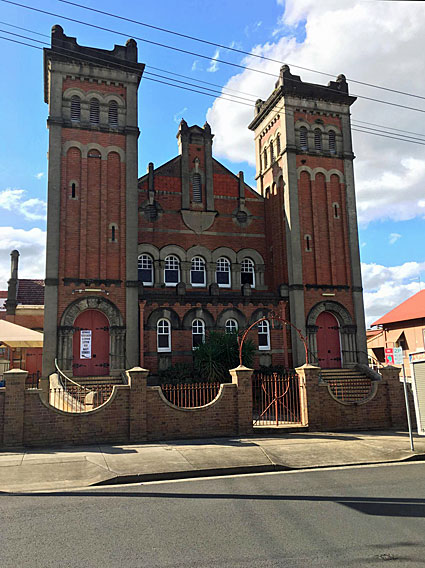
The Uniting Church, Lismore
[Photograph by James Goldrick (July 2017)]

The Uniting Church, Lismore
[Photograph by James Goldrick (July 2017)]
Historical and Technical Documentation by Geoffrey Cox
© OHTA 2018 (last updated August 2018)
The first Methodist Church in Lismore was erected in 1881. It was replaced by the present structure, of Romanesque design, in May 1909.1
The organ was installed shortly after the present church was opened in 1909, having been built in 1897 as a small instrument of 1 manual and 6 stops for St Clement's Anglican Church, Mosman:
ST. CLEMENT'S, MOSMAN.
The Primate yesterday morning consecrated the new organ at St. Clement's, Mosman. The organ was built by Mr. Charles Richardson, and is of handsome appearance, and constructed of colonial woods, the case being of kauri pine and the outer speaking tubes of metal faced with aluminium. The instrument consists of a one-manual and pedal organ and six stops. Mrs. Garling presided at the organ, which was heard to special advantage in the voluntary of dedication, Batiste's Communion in E flat.2
The specification at Mosman was as follows:
| MANUAL (56 notes) Open Diapason Stopped Diapason Bass Rohr Flute Dulciana Principal Fifteenth PEDAL (12 notes) Bourdon COUPLER Pedal to Manual.3 |
8 8 8 8 4 2 16 |
The organ was sold in August 1909 to the Methodist Church, Lismore, to make way for a larger organ at Mosman.4 For its installation at Lismore, Charles Richardson enlarged the instrument to 2 manuals, 14 speaking stops and 3 couplers, with pneumatic action on the pedals:
The organ has been built by Mr. C. Richardson, of Sydney, of the firm of W.E. Richardson and Sons, London and Manchester. It is a two manual instrument; the pedals being pneumatic, concave. All the metal pipes are of best white spotted metal. The bellows, which are supplied by two feeders, are large and ample for a full supply of wind for its 654 pipes and the various pneumatic attachments. The organ contains 14 speaking stops, 6 on the great, 7 on the swell, with bourdon 16ft. tone on the pedal, 3 couplers, 4 pneumatic pistons, and tremulant.5
The organ was opened on Sunday 10 October with a recital at the close of the evening service,6 and two further recitals were given during the following week by Mr. Cecil Compton, organist of Christ Church Cathedral, Grafton.7 The organ was initially blown by hand, and the console was placed in front of the pulpit:
The organ has been erected on the vestry side of the church, with the pulpit between it and the choir gallery. Mr. Strong sat at the organ last night, and his playing brought out in a marked manner the beautiful individuality of the stops, the clarionet and oboe being particularly sweet.8
In conjunction with the jubilee celebrations of the church, the organ was rebuilt and enlarged by S.T. Noad and Son in 1959.9 The specification was recorded as containing 21 speaking stops with 8 couplers.10
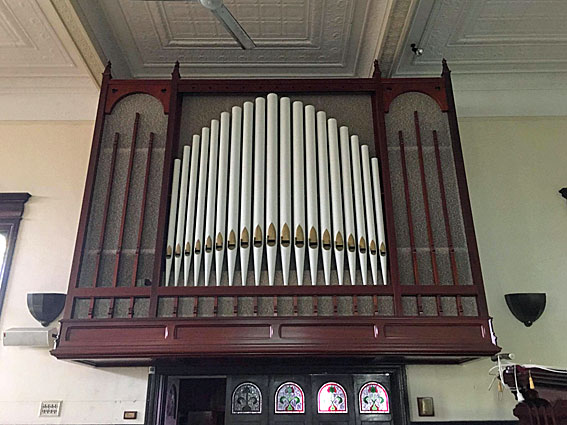
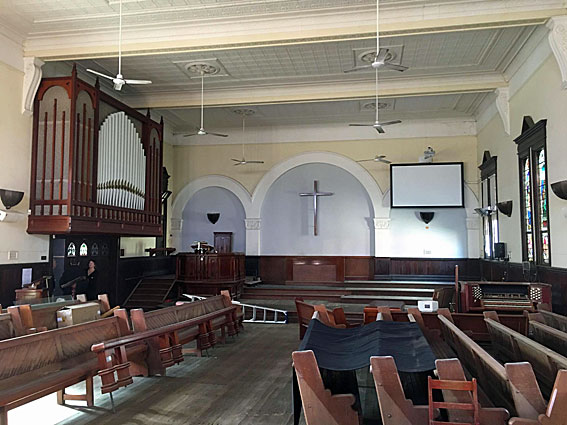
The organ rebuilt by S.T. Noad
[Photographs by James Goldrick (July 2017)]
Two pedal stops were later added, presumably by extension, enlarging the specification to 23 speaking stops and 9 couplers. These additions were possibly made in association with the dedication of a new console in memory of Arthur Howard Brockington, organist 1927-1977.
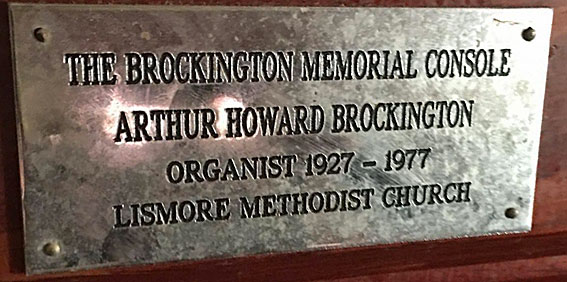
Memorial plaque on the console
[Photograph by James Goldrick (July 2017)]
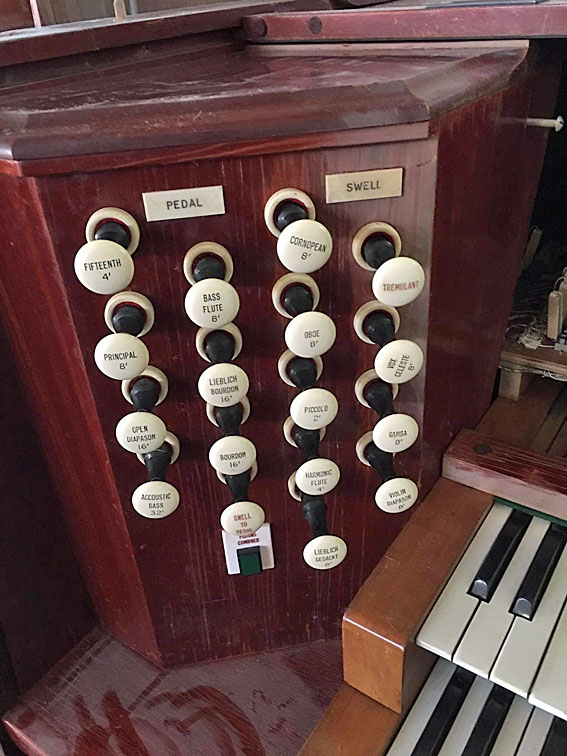
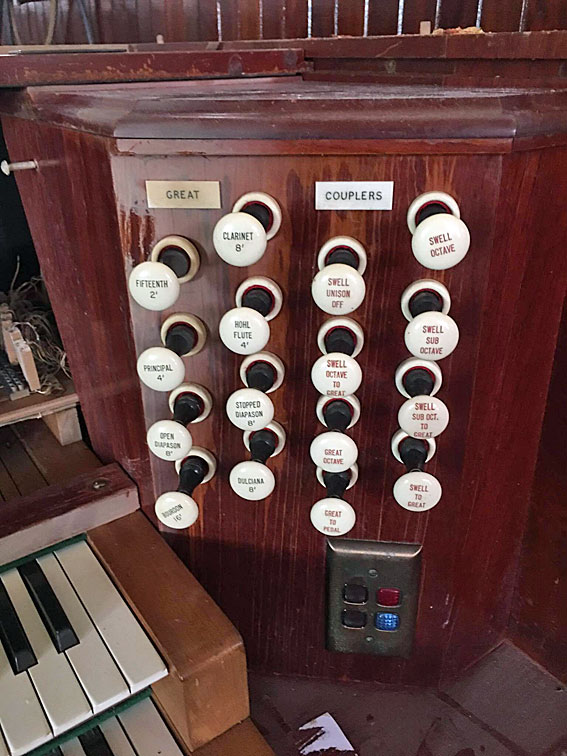
Stop Jambs
[Photographs by James Goldrick (July 2017)]
The specification is:
| Great Bourdon Open Diapason Stopped Diapason Dulciana Principal Hohl Flute Fifteenth Clarinet Swell Violin Diapason Lieblich Gedackt Gamba Vox Celeste Harmonic Flute Piccolo Oboe Cornopean Tremulant Pedal Acoustic Bass Open Diapason Bourdon Lieblich Bourdon Prinicpal Bass Flute Fifteenth Couplers Swell to Pedal Great to Pedal Swell to Great Swell Octave Swell Sub Octave Swell Unison Off Swell Octave to Great Swell Sub Octave to Great Great Octave |
16 8 8 8 4 4 2 8 8 8 8 8 4 2 8 8 32 16 16 16 8 8 4 |
Compass: 61/30
Detached drawstop console
Pistons combined switch.11
The church was flooded in the Lismore floods at the end of March 2017,12 at which time the organ became unplayable. The water level rose sufficiently high to submerge the console, although the pipework and windchests escaped damage.
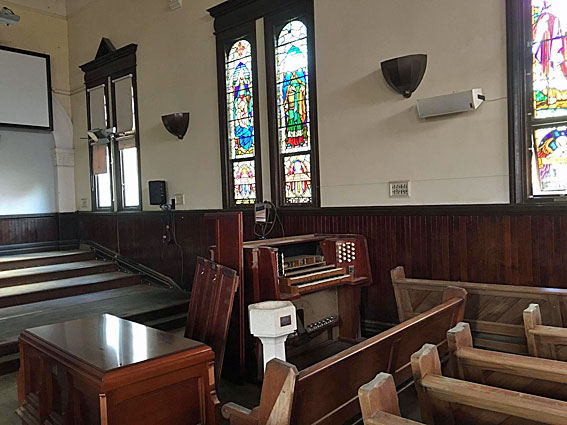
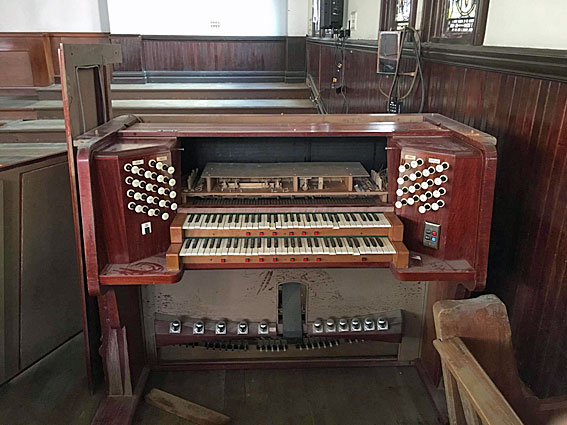
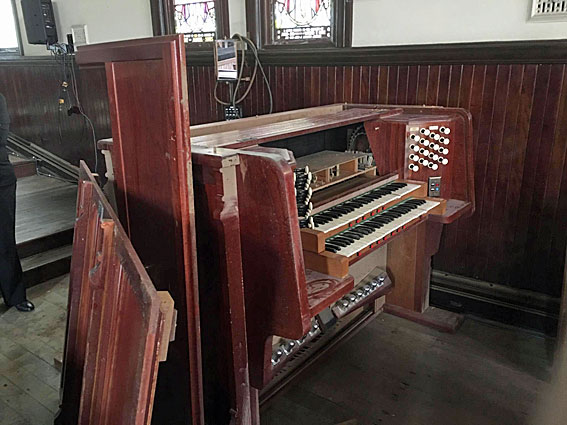
The water-damaged console
[Photographs by James Goldrick (July 2017)]
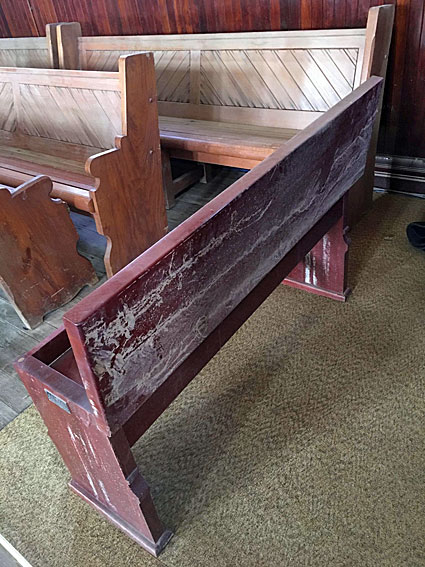
The flood water level visible on the back of this pew
[Photograph by James Goldrick (July 2017)]
It is reported that there are no plans to repair the console, and the instrument is likely to be abandoned.13
_______________________________________________________________
1 The Casino and Kyogle Courier (19 May 1909), p. 5; The Methodist (19 June 1909), p. 10.
2 The Evening News (Mosman, 11 January 1897), p. 8.
3 Arthur Massey, Specification of Organ built by C. Richardson … for St Clement's Church Mosman (document, c.1909), cited in Graeme Rushworth, Historic Organs of New South Wales (Sydney: Hale & Iremonger, 1988), p. 127.
4 Rushworth, pp. 127, 134, 196.
5 The Northern Star (Lismore, 12 October 1909), p. 3.
6 The Methodist (16 October 1909), p. 7.
7 The Grafton Argus and Clarence River General Advertiser (8 October 1909), p. 8.
8 Loc. cit.
9 Rushworth, pp. 127, 134.
10 Specification noted by Bill McKelvie, 1974; recorded in John Maidment, Gazetteer of New South Wales Pipe Organs (Melbourne: Society of Organists (Vic), 1981).
11 Specification from stop jambs photographed by James Goldrick, July 2017.
12 'Lismore Residents forced to start anew after ex-Cyclone Debbie,' Insights Magazine (4 April 2017).
13 Ian D. Brown and Associates Newsletter (December 2017); rpt. in The Sydney Organ Journal, vol. 49, no. 1 (Summer 2017-18), p. 45.
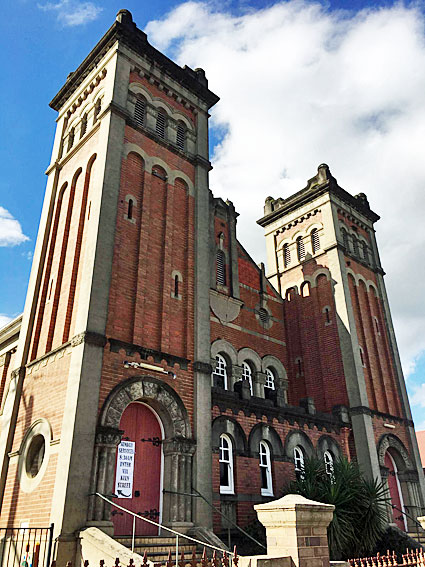
[Photograph by James Goldrick (July 2017)]